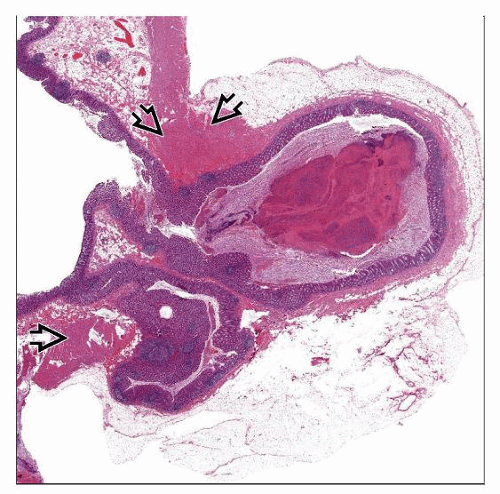Diverticular Disease
Sharon K. Bihlmeyer, MD
Key Facts
Terminology
Outpouching from tubular structure
True diverticula involve all layers
False diverticula when outpouching only involves some of layers (mucosa and submucosa)
Etiology/Pathogenesis
Low-fiber diet
Clinical Issues
Incidence is 30% of adults in Western countries
Prevalence increases with age; 60% of patients over 70 years old
Prevalence highest in western societies and those with Western-type diet
Symptoms include abdominal pain and hematochezia
May be asymptomatic and incidentally discovered on screening colonoscopy
May remain asymptomatic, create chronic pain, or be complicated by diverticulitis
Macroscopic Features
Markedly thickened colon wall
Redundant or polypoid mucosal folds
Microscopic Pathology
Herniation of mucosal and submucosal layers through muscularis propria (circular muscle)
Mucosal redundancy with prolapsing mucosal folds
Top Differential Diagnoses
Polyp
Diverticula disease-related colitis
TERMINOLOGY
Definitions
Outpouching from tubular structure (lumen of gastrointestinal tract)
True diverticula involve all layers of intestinal wall
Congenital and right-sided diverticula in Asian populations are true diverticula
False diverticula when outpouching involves only some layers (mucosa and submucosa)
Acquired left-sided diverticula in Western nations are false diverticula
Diverticulitis = inflammation of diverticulum
False diverticula of colon = pseudodiverticula
ETIOLOGY/PATHOGENESIS
Developmental Anomaly
Patients with inherited collagen and elastin disorder syndromes develop diverticula at early age
Marfan syndrome
Ehlers-Danlos syndrome
Neuromuscular diseases
Visceral neuropathy and visceral myopathy
Multiple diverticula including small bowel
Multiple endocrine neoplasia type 2B
Systemic sclerosis (scleroderma)
Multiple diverticula including small bowel
Environmental Exposure
Low-fiber diet
Diets with small quantities of fruit and vegetable fiber
Lower volume stools cause alterations in colonic motility
Increased intraluminal pressures are transmitted to colonic wall
CLINICAL ISSUES
Epidemiology
Incidence
30% of adults in Western countries
50% of individuals > 40 years of age have diverticular disease
Up to 60% of patients > 70 years old
Age
Mean age 58 years
Prevalence increases with age
Gender
Affects both sexes equally
Ethnicity
Geographical differences in prevalence
Prevalence highest in Western societies and those with Western-type diet
Prevalence lowest in societies with high-fiber diet
< 2% in rural Africa
Asian individuals who have adopted Western lifestyle develop diverticulosis
Study of Japanese shows they originally had unique diverticula (unlike western nations)
Predominately right-sided, true diverticula, congenital, low incidence, and male predominance
Now have increase in bilateral disease (right and left colon, increased prevalence with age)
Site
Left colon with rectal sparing in Western nations
Right colon in Asian countries
Rarely pancolonic
Occur at inherent weakness in bowel wall where vasa recta penetrate muscularis
Presentation
Fever
With left lower quadrant pain and leukocytosis in acute diverticulitis
Abdominal pain
Many patients labeled with irritable bowel syndrome
Hematochezia
Especially in right-sided disease
Stay updated, free articles. Join our Telegram channel

Full access? Get Clinical Tree






